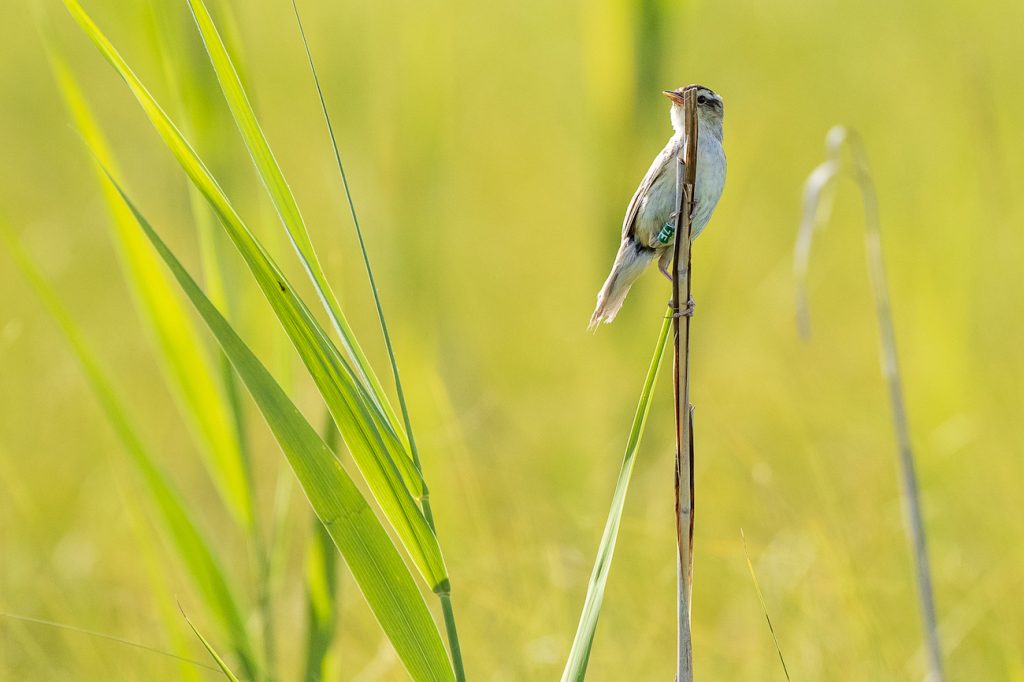First ever Aquatic Warbler translocation confirmed to be effective

Kącik ornitologiczny na festiwalu Bazuna 2019
24 czerwca 2019
First ever Aquatic Warbler translocation confirmed to be effective
27 czerwca 2019
Translocated Aquatic Warbler that came back to Lithuania after wintering in Africa
The first female Aquatic Warbler count was completed this week in the Žuvintas Biosphere Reserve, Lithuania. It revealed that out of the 49 birds brought from Belarus and released into freedom last year, at least 11 have returned, and translocated female birds are successfully raising nestlings. In the search for Aquatic Warblers in the Žuvintas lakeside fenmires, Žuvintas Biosphere Reserve workers and experienced ornithologists from Belarus and Lithuania participated.
“This week, as colleagues from Belarus visited Žuvintas, they were able to find two female Aquatic Warblers that had been translocated to Žuvintas last year, and who successfully returned after wintering in Africa. Ornithologists also found these mothers’ nestlings, flying throughout the fenmire. This means that the translocated Aquatic Warblers successfully adapted to life in the wild. Researchers also observed 9 male birds, which we had previously found. International experts did not expect such a positive result—this percentage of returned birds is greater than the natural first-year bird return rate, which is 20 percent,” said species conservation project leader and Baltic Environmental Forum Lithuania director, Žymantas Morkvėnas, when speaking of the first ever Aquatic Warbler translocation results.
Naturalists think there may be even more returned birds. “This week, during the search, most of the mother birds stayed low by the reeds, while their young birdlings could be found already flying themselves. This shows that they have raised their first wave of offspring, but not yet their second. Observing mothers that currently have nestling dependants is very complicated. In the near future, we will have more time for observation when we move to live in the fenmires together with the translocated young Aquatic Warblers. It’s possible that even more female Aquatic Warblers will be found, “ thinks Baltic Environmental Forum Lithuania ornithologist Gintaras Riauba.
This month, Dr. Martin Flade, German researcher and the International Aquatic Warbler Conservation Group chairman, who has studied this species for over 20 years, visited Lithuania. He declared that the achievements of his colleagues from Lithuania and Belarus overjoyed him. “The translocation of the Aquatic Warbler from the Zvaniec fenmire of Belarus to the Žuvintas Biosphere Reserve is a part of the international strategy in this species conservation. From a scientific perspective, the Aquatic Warbler translocation is constantly and thoroughly deliberated. I am impressed by the translocation results. An international Scientific Advisory Board who came to Žuvintas last year, agreed that if just 20% of translocated younglings (that being 10 birds) returned the next year, that would be a remarkable achievement for the translocation program. The current result already tops all previous expectations. The translocation’s successful results in this country will help direct the international conservation of this species, and using this method, we might be able to revive this species population in Europe. We, researchers in Germany, are seriously prepared to learn from our Lithuanian and Belarusian colleagues and repeat the translocation method in the rebuilt habitats in our country. The same is hoped to be done in Poland and Hungary,” said Dr. Martin Flade.
The Aquatic Warbler translocation program is now on its second year. Overall, 100 endangered nestlings have been brought to the Žuvintas Biosphere Reserve from Belarus. The first Aquatic Warbler translocation period was last year. 98% of the translocated birds were successfully raised and released into freedom. Now we know that out of those, at least 11 birds returned. This year, another 50 nestlings have been brought to Žuvintas. As of today, they are all successfully growing, and this week, they were moved into outdoor aviaries, specially prepared for them.
The Aquatic Warbler translocation is just one of many actions of this species conservation project that has been going on for three years now in Lithuania and Belarus, and it uses only 5% of the total budget. During the project, 20,000 ha of habitats, in which many Aquatic Warbler neighbors such as great snipes, common redshanks, and corncrakes live, will also be rebuilt. Additionally, water level control devices will be installed and biomass recycling stations in Dreverna will be built, helping solve the long-lived issue of disposing of leftover harvest biomass. The project also calls for wildlife education and communication.
Get to know more about the success of the first ever translocation with the species, interesting stories about the birds and devoted team members, and, of course, how our sick baby-bird succeeded, by watching video diary.
More about Aquatic Warbler conservation in Lithuania and Belarus on: https://meldine.lt/en/
The Aquatic Warbler conservation activities in Belarus are implemented by the “LIFE” project “LIFE MagniDucatus Acrola” in synergy with the UNDP-GEF “Wetlands” project.



